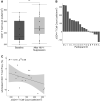Decreased Activated CD4+ T Cell Repertoire Diversity After Antiretroviral Therapy in HIV-1/HCV Coinfection Correlates with CD4+ T Cell Recovery
- PMID: 34672777
- PMCID: PMC8917883
- DOI: 10.1089/vim.2021.0027
Decreased Activated CD4+ T Cell Repertoire Diversity After Antiretroviral Therapy in HIV-1/HCV Coinfection Correlates with CD4+ T Cell Recovery
Abstract
Dysfunctional immune activation accumulates during chronic viral infection and contributes to disease pathogenesis. In HIV-1, immune activation is exacerbated by concurrent infection with hepatitis C virus (HCV), accelerating depletion of CD4+ T cells. HIV-1 suppression with antiretroviral therapy (ART) generally reconstitutes CD4+ T cell counts, while also reducing the proportion that is activated. Whether this immune reconstitution also reduces the complexity of the CD4+ T cell population is unknown. We sought to characterize the relationship between activated CD4+ T cell repertoire diversity and immune reconstitution following ART in HIV-1/HCV coinfection. We extracted T cell receptor (TCR) sequences from RNA sequencing data obtained from activated CD4+ T cells of HIV-1/HCV coinfected individuals before and after treatment with ART (clinical trial NCT01285050). There was notable heterogeneity in both the extent of CD4+ T cell reconstitution and in the change in activated CD4+ TCR repertoire diversity following ART. Decreases in activated CD4+ TCR repertoire diversity following ART were predictive of the degree of CD4+ T cell reconstitution. The association of decreased activated CD4+ TCR repertoire diversity and improved CD4+ T cell reconstitution may represent loss of nonspecifically activated TCR clonotypes, and possibly selective expansion of specifically activated CD4+ clones. These results provide insight into the dynamic relationship between activated CD4+ TCR diversity and CD4+ T cell recovery of HIV-1/HCV coinfected individuals after suppression of HIV-1 viremia.
Keywords: CD4-positive T lymphocytes; HIV; T cell; antigen; coinfection; hepatitis C; immune reconstitution; receptors.
Conflict of interest statement
No competing financial interests exist.
Figures




Similar articles
-
Modelling CD4 T Cell Recovery in Hepatitis C and HIV Co-infected Children Receiving Antiretroviral Therapy.Pediatr Infect Dis J. 2017 May;36(5):e123-e129. doi: 10.1097/INF.0000000000001478. Pediatr Infect Dis J. 2017. PMID: 28403051 Free PMC article.
-
Impact of hepatitis C viral replication on CD4+ T-lymphocyte progression in HIV-HCV coinfection before and after antiretroviral therapy.AIDS. 2010 Jul 31;24(12):1857-65. doi: 10.1097/QAD.0b013e32833adbb5. AIDS. 2010. PMID: 20479633
-
Influence of Hepatitis C virus coinfection on immune reconstitution in HIV subjects.Med Microbiol Immunol. 2019 Dec;208(6):747-756. doi: 10.1007/s00430-019-00619-4. Epub 2019 May 30. Med Microbiol Immunol. 2019. PMID: 31147782
-
A Tale of Two Viruses: Immunological Insights Into HCV/HIV Coinfection.Front Immunol. 2021 Aug 12;12:726419. doi: 10.3389/fimmu.2021.726419. eCollection 2021. Front Immunol. 2021. PMID: 34456931 Free PMC article. Review.
-
Special considerations in the initiation and management of antiretroviral therapy in individuals coinfected with HIV and hepatitis C.AIDS. 2004 Nov 19;18(17):2221-34. doi: 10.1097/00002030-200411190-00002. AIDS. 2004. PMID: 15577534 Review.
Cited by
-
Evaluation of Clinical Biomarkers Related to CD4 Recovery in HIV-Infected Patients-5-Year Observation.Viruses. 2022 Oct 18;14(10):2287. doi: 10.3390/v14102287. Viruses. 2022. PMID: 36298842 Free PMC article.
References
-
- Anthony KB, Yoder C, Metcalf JA, et al. . Incomplete CD4 T cell recovery in HIV-1 infection after 12 months of highly active antiretroviral therapy is associated with ongoing increased CD4 T cell activation and turnover. J Acquir Immune Defic Syndr 2003;33:125–133. - PubMed
-
- Badano MN, Parodi C, Aloisi N, et al. . Influence of Hepatitis C virus coinfection on immune reconstitution in HIV subjects. Med Microbiol Immunol 2019;208:747–756. - PubMed
Publication types
MeSH terms
Grants and funding
LinkOut - more resources
Full Text Sources
Medical
Research Materials

